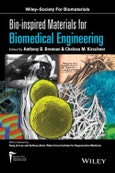This book covers the latest bio-inspired materials synthesis techniques and biomedical applications that are advancing the field of tissue engineering. Bio-inspired concepts for biomedical engineering are at the forefront of tissue engineering and regenerative medicine. Scientists, engineers and physicians are working together to replicate the sophisticated hierarchical organization and adaptability found in nature and selected by evolution to recapitulate the cellular microenvironment. This book demonstrates the dramatic clinical breakthroughs that have been made in engineering all four of the major tissue types and modulating the immune system.
Part I (Engineering Bio-inspired Material Microenvironments) covers Bio-inspired Presentation of Chemical Cues, Bio-inspired Presentation of Physical Cues, and Bio-inspired Integration of Natural Materials.
Part II (Bio-inspired Tissue Engineering) addresses tissue engineering in epithelial tissue, muscle tissue, connective tissue, and the immune system.
Table of Contents
Contributors vii
Preface xi
Introduction 1
Sang Jin Lee and Anthony Atala
Part I Engineering Bio-Inspired Material Microenvironments 5
Chapter 1 ECM-Inspired Chemical Cues: Biomimetic Molecules and Techniques of Immobilization 7
Roger Y. Tam, Shawn C. Owen, and Molly S. Shoichet
Chapter 2 Dynamic Materials Mimic Developmental and Disease Changes in Tissues 25
Matthew G. Ondeck and Adam J. Engler
Chapter 3 The Role of Mechanical Cues in Regulating Cellular Activities and Guiding Tissue Development 45
Liming Bian
Chapter 4 Contribution of Physical Forces on the Design of Biomimetic Tissue Substitutes 59
Menekse Ermis, Erkan Türker Baran, Tuğba Dursun, Ezgi Antmen, and Vasif Hasirci
Chapter 5 Cellular Responses to Bio-Inspired Engineered Topography 77
Chelsea M. Kirschner, James F. Schumacher, and Anthony B. Brennan
Chapter 6 Engineering The Mechanical and Growth Factor Signaling Roles of Fibronectin Fibrils 99
Christopher A. Lemmon
Chapter 7 Biologic Scaffolds Composed of Extracellular Matrix as a Natural Material for Wound Healing 111
Elizabeth W. Kollar, Christopher L. Dearth, and Stephen F. Badylak
Chapter 8 Bio-Inspired Integration of Natural Materials 125
Albino Martins, Marta Alves da Silva, Ana Costa-Pinto, Rui L. Reis, and Nuno M. Neves
Part II Bio-Inspired Tissue Engineering 151
Chapter 9 Bio-Inspired Design of Skin Replacement Therapies 153
Dennis P. Orgill
Chapter 10 Epithelial Engineering: From Sheets to Branched Tubes 161
Hye Young Kim and Celeste M. Nelson
Chapter 11 A Biomimetic Approach Toward The Fabrication of Epithelial-Like Tissue 175
Hongjun Wang and Meng Xu
Chapter 12 Nano- and Microstructured ECM and Biomimetic Scaffolds for Cardiac Tissue Engineering 195
Quentin Jallerat, John M. Szymanski, and Adam W. Feinberg
Chapter 13 Strategies and Challenges for Bio-Inspired Cardiovascular Biomaterials 227
Elaine L. Lee and Joyce Y. Wong
Chapter 14 Evaluation of Bio-Inspired Materials for Mineralized Tissue Regeneration Using Type I Collagen Reporter Cells 259
Liisa T. Kuhn, Emily Jacobs, and A. Jon Goldberg
Chapter 15 Learning from Tissue Equivalents: Biomechanics and Mechanobiology 281
David D. Simon and Jay D. Humphrey
Chapter 16 Mimicking the Hematopoietic Stem Cell Niche by Biomaterials 309
Eike Müller, Michael Ansorge, Carsten Werner, and Tilo Pompe
Chapter 17 Engineering Immune Responses to Allografts 327
Anthony W. Frei and Cherie L. Stabler
Chapter 18 Immunomimetic Materials 357
Jamal S. Lewis and Benjamin G. Keselowsky
Index 371








